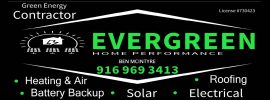As the demand for sustainable energy solutions continues to rise, many homeowners are considering solar panels to reduce their electricity bills and environmental impact. However, understanding the full cost of installing a residential solar system—and the potential return on investment (ROI)—remains a key concern.
This guide from Evergreen HP provides a transparent breakdown of solar panel installation costs, available financial incentives, long-term savings, and key factors influencing ROI.
Average Cost of Solar Panel Installation in the U.S.
The cost of residential solar panel systems can vary significantly depending on the size, type of equipment, and regional factors. As of 2024, the average cost of a solar panel system in the U.S. is around $2.50 to $3.50 per watt.
Typical System Sizes and Total Cost:
| System Size | Estimated Cost (Before Incentives) |
|---|---|
| 4 kW | $10,000 – $14,000 |
| 6 kW | $15,000 – $21,000 |
| 8 kW | $20,000 – $28,000 |
| 10 kW | $25,000 – $35,000 |
These figures generally include hardware (panels, inverters, racking), labor, permitting, and administrative fees.
Federal and State Solar Incentives
Government incentives play a significant role in reducing the upfront cost of solar systems.
Federal Investment Tax Credit (ITC)
The Federal Solar Investment Tax Credit offers a 30% tax credit for residential solar installations. This credit applies to both equipment and installation costs.
For example:
-
A $20,000 system qualifies for a $6,000 tax credit, reducing the net cost to $14,000.
State and Local Programs
Many states offer additional incentives, such as:
-
Cash rebates
-
Property tax exemptions
-
Performance-based incentives (PBIs)
-
Sales tax exemptions
To check available incentives in your area, refer to the Database of State Incentives for Renewables & Efficiency (DSIRE).
Return on Investment (ROI) and Payback Period
What Is ROI for Solar Panels?
ROI refers to the total value of savings generated by the system compared to its cost. For residential solar systems, ROI typically comes from:
-
Lower electricity bills
-
Net metering credits
-
Tax incentives
Typical Payback Period
Most homeowners recoup their solar investment in 6 to 12 years, depending on:
-
Electricity rates
-
Local incentives
-
Sunlight exposure
-
Energy consumption
Example:
-
System Cost After Incentives: $15,000
-
Annual Utility Savings: $1,500
-
Estimated Payback Period: 10 years
-
System Lifespan: 25–30 years
After the break-even point, all energy savings contribute to net profit.
Long-Term Utility Bill Savings
One of the most tangible benefits of solar is the reduction in electricity costs.
Average Monthly Savings:
Homeowners typically save $100–$150 per month on electricity bills. Over 25 years, that adds up to $30,000–$45,000, depending on the size of the system and electricity rates.
With rising energy prices, solar can act as a hedge against future utility cost increases.
Maintenance Costs and System Longevity
Solar systems are known for low maintenance requirements. Key points include:
-
Inverter Replacement: Inverters may need replacing after 10–15 years; costs range from $1,000 to $2,500.
-
Panel Cleaning: Optional in many regions, but can be done once or twice a year at minimal cost.
-
Warranty Coverage: Most panels come with 25-year performance warranties and 10–15-year equipment warranties.
Routine monitoring ensures your system operates efficiently, but no major ongoing costs are typically involved.
Financing Options for Homeowners
Homeowners can choose from several financing models based on their budget and preferences:
1. Cash Purchase
-
Pros: Highest ROI, full ownership, eligible for all incentives.
-
Cons: High upfront cost.
2. Solar Loans
-
Pros: Low to no upfront cost, still eligible for tax credits.
-
Cons: Monthly loan payments may reduce immediate savings.
3. Leases and Power Purchase Agreements (PPAs)
-
Pros: No upfront cost; system is maintained by the provider.
-
Cons: Lower long-term savings; incentives go to the installer, not the homeowner.
Choosing the right financing depends on individual financial goals, credit score, and available capital.
Key Factors That Affect Cost and ROI
Several variables influence the actual cost and ROI of a solar system:
| Factor | Impact on ROI |
|---|---|
| Location | Sunlight exposure and utility rates vary by region |
| Roof Type & Angle | Affects installation complexity and energy efficiency |
| Panel Efficiency | High-efficiency panels cost more but deliver better performance |
| Local Incentives | More incentives = faster payback |
| Net Metering Rules | Determines how excess power is credited |
For example, a home in Arizona or California—where sun exposure is high and electricity rates are steep—will likely see faster ROI than one in a less sunny state with lower energy costs.
Is Solar Worth It for You?
Going solar is not a one-size-fits-all decision. Here’s a quick checklist to help homeowners evaluate:
✅ Your roof gets direct sunlight for most of the day
✅ You plan to live in your home for 7+ years
✅ Your local utility rates are high
✅ State or local incentives are available
✅ You’re eligible for the 30% federal tax credit
If most of these boxes are checked, the long-term savings and environmental benefits could make solar a smart investment.
Final Thoughts
Installing solar panels can be a significant upfront investment, but with the help of federal incentives, local rebates, and long-term utility savings, the return on investment is often compelling. Most homeowners break even in under a decade and enjoy decades of reduced energy bills.
At Evergreen HP, our mission is to make solar energy accessible, understandable, and valuable for homeowners across the country. Whether you’re just starting your research or ready for a custom quote, we’re here to guide you through every step.
Interested in learning more about solar panel installation or getting a personalized estimate?
Contact Us today or speak with a certified energy advisor.



